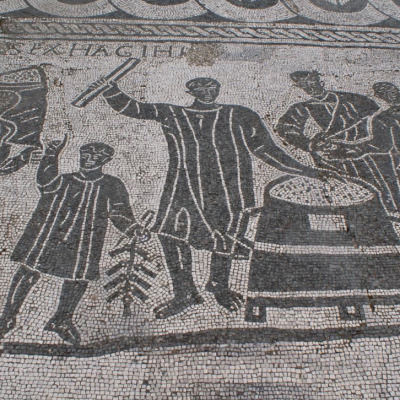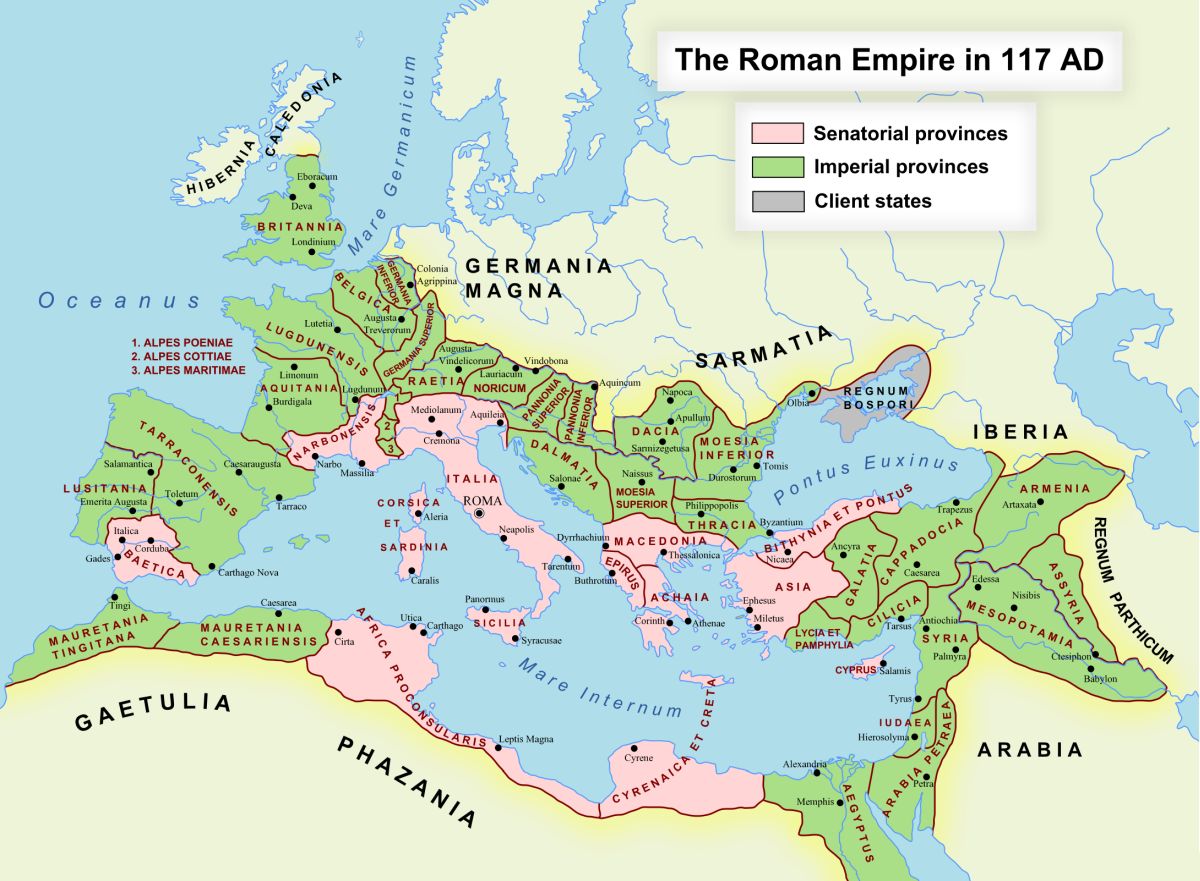Chapters
Attempting to assess the number of inhabitants of the Roman Empire throughout history is an extremely difficult task that has been faced and faced to this day by many scientists. The main reason for this is that there are not many reliable sources on this topic. One of the most credible analyzes is the position of the Polish historian Wiesław Suder entitled “Census populi. Demografia starożytnego Rzymu” or books by historian Kyle Harper.
It is a great difficulty for researchers to determine the approximate population inhabiting selected ancient urban centres – such as Rome, Alexandria or Athens. We do have censuses of the civilian population, of course, but the biggest problem is still understanding how large, for example, the slave population was in the areas.
Population of the Roman state
The first credible records of the population of the Roman state appear in the 4th century BCE. The earlier period is marked by numerous indications that allow the assumption that there was a significant demographic expansion in areas of intense urban development, such as in Greater Greece and Etruria, unlike the situation. demographic in the Apennine Peninsula and the Po Plain.
A high rate of demographic growth certainly occurred in the Latin area in the 4th century BCE. This can be deduced from the number of Latin colonies founded by the Roman state during the conquest of Italy. The territorial conquests after the Latin Wars in 340-338 BCE increased the area of the Roman state to 7,000 square kilometres. At that time, they were inhabited by about 600 thousand people with Roman citizenship (this is a hypothetical number, resulting from multiplication by four of the number of approx. 150 thousand adult men subject to the census; thus we also include families), with an average of 85 people per sq. km.
In 265 BCE, the Roman Republic covered a territory of 24 thousand. sq km, with a population of 1,168,936 (multiplied by four 292,234 adult males in the previous year’s census) and an average of 49 people per sq km. the population continued to migrate to the Latin colonies, which were autonomous from Rome.
In 225 BCE the average number of people controlled by Rome dropped to as much as 27 people per square kilometre. To this number should be added the population of allied cities and peoples – then we get about 132 people per square kilometre with a total population of 3.6 million people.
Rome during the Second Punic War clearly lost from the demographic growth, which resulted from large personnel losses during military campaigns. This is confirmed by the census carried out in 209 BCE – Rome then had about 137,000 Roman citizens, while in 234 BCE there were about 270,000 citizens.
At the end of the 2nd century BCE, the number of adult males reached 400,000, and in the 90-88 BCE, when the entire Peninsula was absorbed by Rome, it reached 910,000 (data from the 69 BCE census). The total population can only be determined if we also include slaves and peregrini, that is, foreigners. We can estimate this number at that time at around 4 million people. The territories within the republic were around 165,000. km, where there were 22.5 people per 1 sq km.
Civil wars led to a significant reduction in the population. Only the victory of Octavian Augustus in 31 BCE at Actium and the end of the wars brought about a demographic improvement. This was achieved mainly through the settlement of veterans in rural areas and urban development, especially in the Po Plain. Moreover, other lands, including Egypt, were incorporated into the Empire’s borders.
The census of 14 CE recorded about 5 million citizens of Rome (including women with children aged 1-2), not including the approximately 500,000 legionaries, officials and traders who lived in the provinces. Assessing the number of peregrini at around 500,000 and slaves (about 1 million), this gives us a population of about 6 million people living in the lands from the foothills of the Alps to the borders of Calabria. It is an area of approx. 220 thousand. sq. km, with an average of 27 inhabitants per sq. km.
Developing through the entire era of the Antonin dynasty, town planning ultimately stimulated demographic expansion. At the end of the 2nd century CE, the effects of a serious plague in many regions were felt, but e.g. in the 3rd century CE, there was a visible increase in the population, despite the serious political and military crises of that time, as well as in the 4th century CE, which is linked to with urban and economic growth. Any other, even approximate, data is not extractable due to the lack of any numbers from censuses, which were no longer carried out.
Problems with population assessment on example of city of Rome
The size of the city of Rome itself at its greatest heyday, i.e. between the reign of Octavian Augustus and Constantine I (27 BCE – 337 CE), is a matter of debate among scholars. There are numbers from 600,000 to 1,800,000 inhabitants. Despite the fact that the Roman authorities conducted censuses, no unambiguous statistical data from that period have survived our times. Scientists create their estimates based on various methodologies and sources.
Frumentatio – the bread allocation
One of them is the methodology based on data from the reign of Julius Caesar and Octavian Augustus, and then Caligula and Septimius Severus, which took into account the number of people who could benefit from frumentatio, it was available to every citizen residing in Rome. Under Caesar, this number changed from 320,000 to 150,000 male citizens who turned 17 years of age. The reduction in the number of people eligible for frumentatio may be due to the fact that the excess population was sent to the established Roman colonies.
Moreover, according to Suetonius, Caesar carried out a reform of drafting the census; from now on, frumentatio was only available to Roman citizens who actually lived in the metropolis, and not also to visitors. Taking into account Suetonius’s data on 150,000 men who are Roman citizens, we can assume that they constituted 30-35% of the entire population of citizens in the city. According to researcher Elio Lo Cascio, before the reform, Rome could have been inhabited by 700-750 thousand citizens; after the reform, 430-500 thousand. It is natural, however, that the population was certainly larger because it would have to include foreigners, of course, slaves, freedmen or people removed from the frumentatio system.
The number of people who came under frumentatio during the reign of Augustus increased somewhat to 200,000 male citizens; such information is given by Cassius Dio and Octavian himself in Res gestae.
Researchers also rely on the information contained in Tacitus, Suetonius and Cassius Dio about the transfer of money by Octavian Augustus to all Roman citizens; the deceased emperor was to leave 45 million sestertii for distribution, and Suetonius additionally states that each citizen received 300 sestertii. A quick calculation gives us the sum of 200,000 citizens who received a “gift” from the ruler.
Grain consumption
Another method researchers use to assess the population of the city of Rome is based on information from sources about the amount of grain imported and its consumption. The large population of the city of Rome required a constant supply of grain by sea, as the surrounding fields did not provide enough food for the inhabitants. The basic source of information on the amount of grain imported is Epitome de Caesaribus from the 4th century CE, in which we can read that 20 million mods were imported from Egypt annually (1 modius = 8 l) of grain. Flavius Josephus, in turn, states that the delivery from Egypt allowed meeting the demand of the inhabitants of Rome for four months. Therefore, we can calculate that Rome consumed 60 million fashion grain during the year. On the other hand, based on the accounts of other ancient writers, as to the monthly demand of a soldier (4 modii) or a slave (5 modii), we can conclude that the annual supply within Egypt allowed feeding about 500,000 citizens (with a minimum demand caloric, even 1.5 million).
However, let us not forget that grain was obtained not only by the public but also by private means, which meant that the number could have been higher.
Of course, the big problem of the described method is relying on many sources that come from different periods. On the other hand, the numbers match those drawn with the previous method.
Base on building list
Another method that can be used to assess the size of the Roman population is the Curiosum urbis Romae regionum XIV and Notitia urbis Romae, which list buildings in Rome from the 4th century CE. They divide the city into 14 districts and mention 1,800 domus and 46,000 tenement houses (insulae). Based on this information, researchers argue that the number of citizens is between 700,000 and 1.2 million.
Summary
However, based on the above-mentioned methods, it can be assumed that the population of the city of Rome could in fact reach a million inhabitants if we take into account not only citizens but also foreigners, slaves or freedmen.
It is worth adding that with the transfer of the Empire’s capital from Rome to Constantinople in the 4th century CE, we can speak of a gradual depopulation of the city. At the beginning of the 5th century CE, after Alaric’s conquest of Rome in CE 410, 120,000 citizens were to have access to free bread. Interestingly, however, by the middle of the 5th century, this number had risen to 140,000, proving that Rome still had a significant population for antiquity.
Sample Population of the Roman Empire
According to historian Kyle Harper, during the reign of Octavian Augustus (27 BCE – 14 CE), the Roman state had a population of 60 million, which grew by 0.1% annually. Below is a proposal for the size of the Roman Empire in the middle of the 2nd century CE, according to Kyle Harper’s “The Fate of Rome”.
Region | Number of inhabitants |
| Greece | 3 million |
| Italia and the Islands | 14 million |
| Anatolia | 10 million |
| Africa | 8 million |
| Syria | 6 million |
| Iberia | 9 million |
| Egypt | 5 million |
| Galia and Germania | 12 million |
| Britain | 2 million |
| Danube area | 6 million |
| TOTAL | 75 million |











